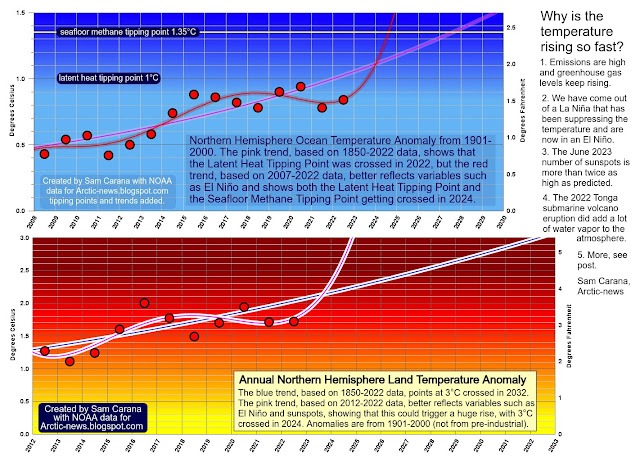by Andrew Glikson
The fast rise in global warming manifested by current extreme weather events betrays a dangerous underestimation of the Earth’s liveable climate, while governments ignore climate science, claim to set limits on domestic emissions, but allow major export of fossil fuels and emissions worldwide on a scale threatening life on Earth. With current policies, there appear to exist few limits on global carbon emissions, as reported by Rogner (1997): “The global fossil resource base is abundant and is estimated at approximately 5000 Gt (billion tons). Compared to current global primary energy use of some 10 Gt per year, this amount is certainly sufficient to fuel the world economy through the twenty-first century”. According to these estimates, future production of coal, oil and gas render a mass extinction of advanced species more than likely.
A significant fraction of carbon gases released from combustion of fossil fuels on timescales of a few centuries remains in the atmosphere as well as leads to acidification of the oceans at a rate faster than its removal by weathering processes and deposition of carbonates. Common measures of the atmospheric lifetime of CO₂ disregard the long time tail of its dissipation, which underestimates the longevity of anthropogenic global warming. Models agree 20–35% of the CO₂ remains in the atmosphere after equilibration with the ocean (over 2–20 centuries). Neutralization by CaCO₃ draws the airborne fraction down further on timescales of 3 to 7 kyr.
With atmospheric CO₂ levels reaching 423 parts per million, according to James Hansen and colleagues humanity is facing a new Frontier, marked by intense heatwaves, more than vindicating warnings by climate scientists over the last 40 years or so. Within less than a century, the levels of CO₂ and temperatures have risen to levels of the Miocene (23.03–5.33 million years ago), with implications for sea level rise (Spratt, 2023). Hominids, living during glacial to inter-glacial periods, rarely had to endure mean temperatures higher than 50°C, which are increasingly common at present. Governments, busy subsidizing new coal mines and oil and gas wells and arming to the teeth for nuclear war, appear to be oblivious to the lessons of the last great world wars.
No longer does climate change represent a future scenario debated by scientists or deniers, but it constitutes an accelerating reality (Figures 1 and 2) related to the latitudinal shift of climate zones, including expansion of the tropics into temperate regions, Europe and north America. The weakening of the circum-polar jet stream allows heat cells to penetrate polar latitudes and cold fronts to enter high latitude zones. The consequences are represented by accumulation of ice melt water off Greenland and parts of the circum-Antarctic ocean (Figure 2). Increased evaporation over land masses results in draughts, while evaporation from warming oceans gives rise to major floods over large continental regions.
According to Sharpless et al. (2023): “Heatwaves have been going through some extraordinary changes in recent history. Since midway through the 20th century, their intensity, frequency and duration have increased across the globe and these changes are happening faster and faster. Research indicates that this is simply not possible without human influence on the climate. A child born today could see an extra 30 to 50 heatwave days every year by the time they are 80, up from roughly four to 10 days today. Southern states of Australia, such as Victoria and South Australia, which already experience the country’s hottest heatwaves, could see hot days become hotter by up to 4 degrees Celsius. There may be more heatwaves in the near future with the Bureau of Meteorology forecasting drier and warmer conditions across much of Australia for July to September this year. These conditions, which often occur during an El Niño, can lead to reduced rainfall, higher temperatures and a greater risk of bushfires. Across Europe, heatwaves may become hotter by up to 10 degrees Celsius and some heatwaves will last up to two months by the end of this century. In just the next 20 years, the USA will experience three to five more heatwaves every decade compared to the second half of the 20th century. Heatwaves are closely linked to droughts. Generally, a large amount of energy from the Sun goes into drying out moisture in the landscape. But as the amount of moisture available for evaporation declines during a drought, more energy is available for heating the air and the temperature rises. This can become a vicious cycle of increasing evaporation and desiccation of the land surface”.
There was a time when kings and generals would fall on their sword when they were defeated, or when their faith in their gods collapsed. Nowadays so-called leaders, assuming opportunistic positions, betray the defence of their own people and of nature, protecting or advancing their own careers. The voices of climate scientists have become subdued, ignored or non-existent. There may not be too many historians to document the 20-21ˢᵗ centuries crimes against humanity and against nature.
Books:
The Asteroid Impact Connection of Planetary Evolution
https://www.springer.com/gp/book/9789400763272
The Archaean: Geological and Geochemical Windows into the Early Earth
https://www.springer.com/gp/book/9783319079073
The Plutocene: Blueprints for a Post-Anthropocene Greenhouse Earth
https://www.springer.com/gp/book/9783319572369
The Event Horizon: Homo Prometheus and the Climate Catastrophe
https://www.springer.com/gp/book/9783030547332
Climate, Fire and Human Evolution: The Deep Time Dimensions of the Anthropocene
https://www.springer.com/gp/book/9783319225111
Evolution of the Atmosphere, Fire and the Anthropocene Climate Event Horizon
https://www.springer.com/gp/book/9789400773318
From Stars to Brains: Milestones in the Planetary Evolution of Life and Intelligence
https://www.springer.com/us/book/9783030106027
Asteroids Impacts, Crustal Evolution and Related Mineral Systems with Special Reference to Australia
https://www.springer.com/us/book/9783319745442
The Fatal Species: From Warlike Primates to Planetary Mass Extinction
https://www.springer.com/gp/book/9783030754679
The Trials of Gaia. Milestones in the evolution of Earth with reference to the Antropocene
https://www.amazon.com.au/Trials-Gaia-Milestones-Evolution-Anthropocene/dp/3031237080


































